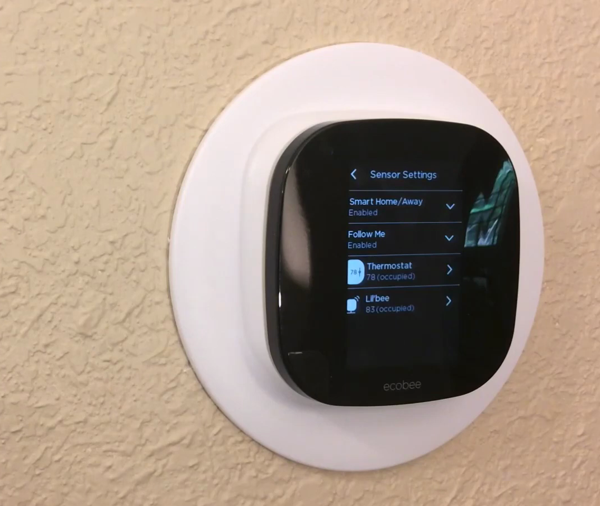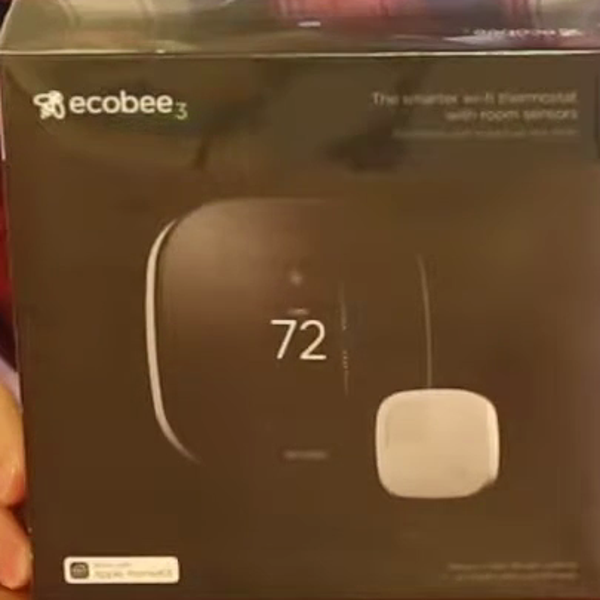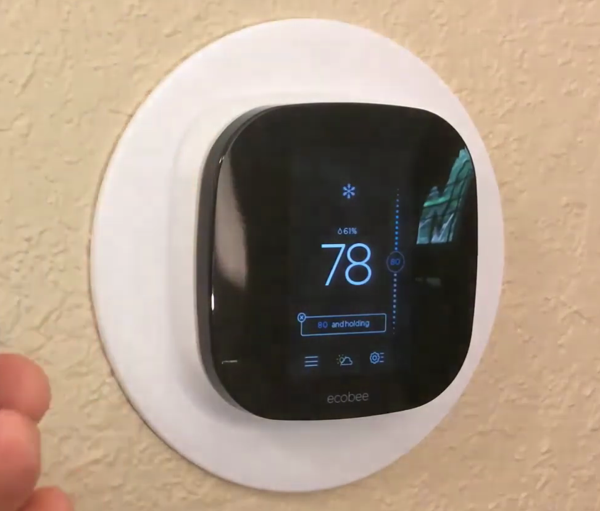Note: As an Amazon Associate I earn from qualifying purchases.
My review of the ecobee3 2nd Gen Smart Wi-Fi Thermostat with Remote Sensor (2024)
Introduction
I recently had the opportunity to test the Ecobee3 Smart Thermostat which allows for easy temperature control and potential energy savings. I generally search for devices that complement my minimalist lifestyle without adding unnecessary clutter or complexity. The Ecobee3 appeared to be an ideal choice for my smart, uncluttered home setup - below are my thoughts on it.
Specifications
| Property | Value | Property | Value |
|---|---|---|---|
| Brand | ecobee | Product Dimensions | 0.37”D x 1.56”W x 1.56”H |
| Controller Type | Vera, Apple HomeKit, Amazon Alexa, SmartThings | Color | Black |
| Power Source | Ac/dc |
Photos
Click on photos to enlarge them:
Prices
Check prices of the ecobee3 2nd Gen Smart Wi-Fi Thermostat with Remote Sensor on:
Enhanced Whole-Home Comfort

When using the Ecobee3 Smart Thermostat, I find the remote sensors particularly advantageous. These sensors measure both temperature and occupancy levels. Here’s why:
The thermostat with sensors in various rooms ensures Consistent Comfort by averaging temperatures instead of relying solely on one location’s reading. This approach guarantees a uniform climate across different spaces.
Occupancy Detection: The system identifies which rooms are being used based on motion detection. It then directs heating or cooling accordingly, focusing on areas that require it.
Installation: Setup was straightforward. If you can follow basic instructions and use a screwdriver, you’re all set.
Customization: The ability to have up to 32 sensors means that whether you live in a compact apartment or a sprawling mansion, the Ecobee3 adapts to your space.
HomeKit Compatibility: This is beneficial for Apple users. They can control the thermostat using Siri or create automations with ease.
However, there are some important considerations:
Sensor Reach: When it comes to Sensor Reach and reliability, I found that my device is capable of covering up to 45 feet. However, the presence of walls can significantly impact its performance. To ensure optimal sensor placement and maximum reliability, I had to conduct thorough experimentation.
Lag Time: The ‘Follow Me’ feature can be a tad sluggish. It’s designed with a delay to prevent the system from reacting too hastily, but patience is key.
In retrospect, I encountered some brief delays in the system’s response to my actions. However, the system’s overall performance was impressive. Initially, I had to adapt to a slight delay from the sensors. Yet, I soon recognized the benefit of its design that prevented unnecessary heating and cooling adjustments, which could unnecessarily increase energy expenses.
All in, remote sensors bring significant improvements for climate control in multi-room and multi-level homes. Unlike single sensor thermostats, they customize the climate experience, making them essential for larger living spaces. While Ecobee3 might be pricier than single sensor systems for smaller areas, the cost of additional sensors in larger homes justifies itself through enhanced comfort and energy savings.
One important aspect to acknowledge is the learning curve. These setups offer numerous customization options, which some may find overwhelming. It took me several days to configure the settings according to my requirements. However, the learning process is valuable as it grants control and comfort in the end.
My main finding is that the Ecobee3 significantly improves whole-home comfort, though setup and learning are required. Temperature uniformity across all rooms offers a noticeable improvement in comfort. Occasional sensor lag and signal issues are manageable, and the advantages outweigh these minor inconveniences.
Intelligent Heating and Cooling

As a tech-savvy homeowner, I was excited to replace my outdated heating and cooling system with the Ecobee3 Smart Thermostat. The prospect of intelligent temperature control and energy savings made this upgrade an appealing choice. However, like all advanced technology, it has its complexities.
When evaluating the merits of a particular option, it is essential to examine both the pros and cons list. Here’s a clear and comprehensive pros and cons list:
Pros:
Sensors placed in different rooms allow for effective monitoring and enhancement of comfort levels.
Adjusts heating or cooling based on your schedule.
Users experience an average savings of 23% on their energy bills.
Ability to connect with multiple smart home platforms such as Apple HomeKit and Amazon Alexa is a significant advantage.
Cons:
Installing and setting up for the first time might be challenging for those less familiar with technology.
Smaller homes or single-story apartments may not provide the full benefits in certain situations.
The “Follow Me” feature may cause temporary discomfort due to lag.
The Ecobee3 effectively learned and adjusted to my home’s energy requirements. Its capability to adapt to external influences, such as weather conditions and occupancy, kept my house comfortable without the need for frequent adjustments. As promised, I observed energy savings, although significant reductions appeared more noticeable over an extended period, particularly during seasonal shifts when heating and cooling demands varied.
One of the notable features is the remote sensors. Placing them in frequently used rooms allows my system to adapt better to my living habits, rather than focusing solely on the temperature around the thermostat. This is especially beneficial for homes with inconsistent room temperatures.
On setting up and customizing the Ecobee3, I encountered some challenges. The process required a considerable amount of time and electrical wiring knowledge. However, the c-wire adapter made things easier for homes without a common wire. The online knowledge base and customer support proved helpful when I needed guidance.
Integration into my smart home system was straightforward. Controlling my thermostat remotely is now a habit. It’s convenient to adjust my home’s climate from anywhere. However, I’ve encountered issues with the app on my Android device recently. I hope these get resolved soon.
Using the Ecobee3, I find a good balance between comfort and energy efficiency. The personalized heating and cooling maintains my desired temperature while saving energy. While there’s a learning curve and initial setup required, I believe home comfort will progress towards systems like the Ecobee3 in the future. Despite its imperfections, it represents a significant advancement for smart home climate control.
Energy Savings Realized

Approaching the ecobee3 smart thermostat from an energy savings perspective, I’ve been keeping a diligent eye on my utility bills since installation. The promise of the ecobee3 is to shave down those costs, and while I can confirm some reductions, there’s a bit more to the story. Here are the nuts and bolts of what I’ve found:
Installation and Setup: Getting the thermostat and sensors up and running was relatively straightforward. The c-wire adapter was a lifesaver, making the process accessible even for those less tech-savvy.
Sensor Placement: I discovered the most effective sensor locations by experimenting. The chosen spots provided accurate temperature readings of my living spaces.
Activity Settings: Customizing the Follow Me and sleep settings ensured that comfort and savings were maximized during occupancy and in the right zones of my home.
Saving Energy with Smart Features: Utilizing “Smart Home/Away” and “Home IQ” is essential for my energy conservation efforts. These features adjust heating and cooling according to occupancy and weather forecasts, minimizing waste.
Now for the results. The ecobee3 has reduced my energy usage, leading to a slight decrease in my electric bill. While the savings aren’t as significant as the advertised 23%, I still consider it a success. Long-term patterns and seasonal changes may lead to more achievable savings in the future.
But let’s discuss some disadvantages. At first, the extensive features and customizations were confusing, which might have led to settings that reduced savings instead of enhancing them. For instance, the Follow Me feature, though innovative, may occasionally cause a delay in the system responding to unoccupied rooms. It took fine-tuning to achieve a balance between comfort and cost-effectiveness.
In fairness, my experience with customer service was mostly positive. When I encountered problems or had questions, I received assistance throughout. This may have prevented additional expenses such as professional installation or service calls.
Looking forward, the sensor batteries’ durability needs monitoring. Currently, they function well, but their maintenance-free nature is yet to be proven over time.
While using the ecobee3 for energy saving has been a mainly rewarding experience, it requires continuous monitoring and adjustments to maximize financial benefits.
Intuitive and User-Friendly Design

I have grown fond of the less intrusive and intuitive design of the Ecobee3 Smart Thermostat since I began using it. Its sleek appearance and user-friendly interface have instantly captured my attention as someone who is passionate about the smart home concept and minimalist design principles. The Ecoboe3’s less intrusive design not only aligns perfectly with my preferences but also helps me to streamline my home management in a subtle and unobtrusive way. However, like any technological device, it is not without its flaws.
Here are some key points that stand out:
Installation Process: The instructions were clear, enabling me to set up the unit independently. A helpful addition was the C-wire adapter.
Sleek Thermostat Design: The thermostat has a modern black design that complements any room decor.
Through App and Web Integration, controlling the system is conveniently at your fingertips whether using your phone or web portal. The integrated app provides real-time access to data on the go, while the comprehensive web interface offers in-depth analysis of the information.
However, when I tried to get the most out of the Ecobee3, I encountered some difficulties.
Initially, there was a significant temperature discrepancy between the thermostat sensors, leading to necessary troubleshooting. The source of the problem was identified as air impacting the sensors due to an insufficient sealing. This issue was remedied through the application of plumber’s putty for proper sealing.
The “Follow Me” feature introduces a noticeable lag in response times, which can be disconcerting at first but becomes acceptable with prolonged use.
The wealth of customization options available may initially seem overwhelming, but it underscores the device’s remarkable adaptability.
In terms of adhering to a minimalistic approach, this gadget is an ideal match. It’s unassuming, doesn’t demand attention, and the remote sensors minimize engagement – simply set it up, leave it alone, and make adjustments only when required.
One element I value is the extensive data collection. This is beneficial for those who enjoy analyzing numbers and have a good grasp of their home’s energy efficiency. However, the complexity results in a learning curve to fully utilize all features.
In conclusion, the Ecobee3 is an ideal solution for managing a minimalistic home. Its sleek design effectively combines sophistication and simplicity, making it a perfect fit for those seeking to optimize their living space. Despite some initial challenges with setup and calibration, this smart thermostat offers substantial benefits in terms of convenience and potential energy savings. With its intuitive interface and advanced features, the Ecobee3 empowers users to efficiently manage their homes and reduce their carbon footprint, making it an excellent investment for anyone striving for a minimalistic lifestyle.



